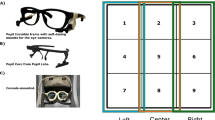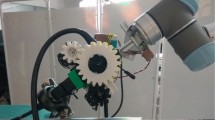Abstract
Purpose
IRIS™ provides interactive, 3D anatomical visualizations of renal anatomy for pre-operative planning that can be manipulated by altering transparency, rotating, zooming, panning, and overlaying the CT scan. Our objective was to analyze how eye tracking metrics and utilization patterns differ between preoperative surgical planning of renal masses using IRIS and CT scans.
Methods
Seven surgeons randomly reviewed IRIS and CT images of 9 patients with renal masses [5 high complexity (RENAL score ≥ 8), 4 low complexity (≤ 7)]. Surgeons answered a series of questions regarding patient anatomy, perceived difficulty (/100), confidence (/100), and surgical plan. Eye tracking metrics (mean pupil diameter, number of fixations, and gaze duration) were collected.
Results
Surgeons spent significantly less time interpreting data from IRIS than CT scans (− 67.1 s, p < 0.01) and had higher inter-rater agreement of surgical approach after viewing IRIS (α = 0.16–0.34). After viewing IRIS, surgical plans although not statistically significant demonstrated a greater tendency towards a more selective ischemia approaches which positively correlated with improved identification of vascular anatomy. Planned surgical approach changed in 22/59 of the cases. Compared to viewing the CT scan, left and right mean pupil diameter and number/duration of fixations were significantly lower when using IRIS (p < 0.01, p < 0.01, p = 0.42, p < 0.01, respectively), indicating interpreting information from IRIS required less mental effort despite under-utilizing its interactive features.
Conclusions
Surgeons extrapolated more detailed information in less time with less mental effort using IRIS than CT scans and proposed surgical approaches with potential to enhanced surgical outcomes.


taken from the field-of-view camera of the head-mounted eye-tracker (HMET). The location of the wearer’s point-of-gaze is indicated by the red circle, the larger the diameter the longer the fixation. Areas of Interest (AOI’s) used for analysis are shown over the imaging (green) and the survey (orange)
Similar content being viewed by others
Abbreviations
- 3D:
-
Three-dimensional
- 3D-AV:
-
Three-dimensional anatomic visualization
- AOI:
-
Areas of interest
- CT:
-
Computed tomography
- ETM:
-
Eye tracking metrics
- HMET:
-
Head-mounted eye-trackers
- MPD:
-
Mean pupil diameter
- PN:
-
Partial nephrectomy
- RN:
-
Radical nephrectomy
- PCS:
-
Renal collecting system
References
Mir MC, Derweesh I, Porpiglia F, Zargar H, Mottrie A, Autorino R (2017) Partial nephrectomy versus radical nephrectomy for clinical T1b and T2 renal tumors: a systematic review and meta-analysis of comparative studies. Eur Urol 71(4):606–617. https://doi.org/10.1016/j.eururo.2016.08.060
Cacciamani GE, Medina LG, Gill TS, Mendelsohn A, Husain F, Bhardwaj L, Artibani W, Sotelo R, Gill IS (2019) Impact of renal hilar control on outcomes of robotic partial nephrectomy: systematic review and cumulative meta-analysis. Eur Urol Focus 5(4):619–635
Marconi L, Desai MM, Ficarra V, Porpiglia F, Van Poppel H (2016) Renal preservation and partial nephrectomy: patient and surgical factors. Eur Urol Focus 2(6):589–600. https://doi.org/10.1016/j.euf.2017.02.012
Kutikov A, Uzzo RG (2009) The R.E.N.A.L. nephrometry score: a comprehensive standardized system for quantitating renal tumor size, location and depth. J Urol 182(3):844–853. https://doi.org/10.1016/j.juro.2009.05.035
Hughes-Hallett A, Mayer EK, Marcus HJ, Cundy TP, Pratt PJ, Darzi AW, Vale JA (2014) Augmented reality partial nephrectomy: examining the current status and future perspectives. Urology 83(2):266–273. https://doi.org/10.1016/j.urology.2013.08.049
Gurung PMS, Melnyk R, Holler T, Oppenhimer D, Witthaus M, Rashid HH, Frye TP, Wu G, Joseph JV, Ghazi AE (2020) Application of IRIS three-dimensional anatomical models as preoperative surgical planning tools in the management of localized renal masses. J Endourol. https://doi.org/10.1089/end.2020.0405
van der Wel P, van Steenbergen H (2018) Pupil dilation as an index of effort in cognitive control tasks: a review. Psychon Bull Rev. 25:2005–2015. https://doi.org/10.3758/s13423-018-1432-y
MenekseDalveren GG, Cagiltay NE (2020) Distinguishing intermediate and novice surgeons by eye movements. Front Psychol 11:542752. https://doi.org/10.3389/fpsyg.2020.542752
Szulewski A, Gegenfurtner A, Howes DW, Sivilotti ML, van Merriënboer JJ (2017) Measuring physician cognitive load: validity evidence for a physiologic and a psychometric tool. Adv Health Sci Educ 22:951–968
Ashraf H, Sodergren MH, Merali N, Mylonas G, Singh H, Darzi A (2018) Eye-tracking technology in medical education: a systematic review. Med Teach 40(1):62–69
Merali N, Veeramootoo D, Singh S (2017) Eye-tracking technology in surgical training. J Investig Surg 32:587
Bertolo R, Autorino R, Fiori C, Amparore D, Checcucci E, Mottrie A, Porter J, Haber GP, Derweesh I, Porpiglia F (2019) Expanding the indications of robotic partial nephrectomy for highly complex renal tumors: urologists’ perception of the impact of hyperaccuracy three-dimensional reconstruction. J Laparoendosc Adv Surg Tech A 29(2):233–239. https://doi.org/10.1089/lap.2018.0486 (Epub 2018 Nov 3 PMID: 30394820)
Checcucci E, Amparore D, Pecoraro A, Peretti D, Aimar R, De Cillis S, Piramide F, Volpi G, Piazzolla P, Manfrin D, Manfredi M, Fiori C, Porpiglia F (2021) 3D mixed reality holograms for preoperative surgical planning of nephron-sparing surgery: evaluation of surgeons’ perception. Minerva Urol Nephrol 73(3):367–375. https://doi.org/10.23736/S0393-2249.19.03610-5
Burgert O, Örn V, Velichkovsky BM, Gessat M, Joos M, Strauss G, Tietjen C, Preim B, Hertel I (2007) Evaluation of perception performance in neck dissection planning using eye tracking and attention landscapes - art. no. 65150B. Proc SPIE. https://doi.org/10.1117/12.709631
Lévêque L, Bosmans H, Cockmartin L, Liu H (2018) State of the art: eye-tracking studies in medical imaging. Ieee Access 6:37023–37034
Wake N, Nussbaum JE, Elias MI, Nikas CV, Bjurlin MA (2020) 3D printing, augmented reality, and virtual reality for the assessment and management of kidney and prostate cancer: a systematic review. Urology 143:20–32
Juvet TS, Thompson RH, Potretzke AM (2020) Robot-assisted partial nephrectomy is safe and effective for complex renal masses when performed by experienced surgeons. Transl Androl Urol 9(6):2474–2478. https://doi.org/10.21037/tau-20-865
Funding
None.
Author information
Authors and Affiliations
Contributions
Protocol/project development: RM, TH, AG. Data collection/management: RM, TH, PS, AG, SQ, JB, WT, TF, HR, JJ. Data analysis: RM, YC, TH, NS, AG. Manuscript writing/editing: RM, TH, PS, NS, AG.
Corresponding author
Ethics declarations
Conflict of interest
None.
Ethical approval
Ethical approval was waived by the RSRB of University of Rochester (STUDY00003003) in view of the retrospective nature of the study and all the procedures being performed were part of the routine care.
Additional information
Publisher's Note
Springer Nature remains neutral with regard to jurisdictional claims in published maps and institutional affiliations.
Supplementary Information
Below is the link to the electronic supplementary material.
Rights and permissions
About this article
Cite this article
Melnyk, R., Chen, Y., Holler, T. et al. Utilizing head-mounted eye trackers to analyze patterns and decision-making strategies of 3D virtual modelling platform (IRIS™) during preoperative planning for renal cancer surgeries. World J Urol 40, 651–658 (2022). https://doi.org/10.1007/s00345-021-03906-z
Received:
Accepted:
Published:
Issue Date:
DOI: https://doi.org/10.1007/s00345-021-03906-z




